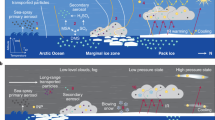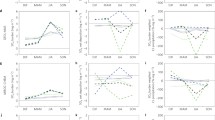Abstract
An energy budget model is used to study the effect on Arctic climate of optically active aerosol in the Arctic atmosphere. The dependence of the change in surface temperature on the vertical distribution of the aerosol and on the radiative properties of the aerosol-free atmosphere, the Arctic surface, and the aerosol, itself, are calculated. An extensive sensitivity analysis is performed to assess the degree to which the results of the model are dependent upon the assumptions underlying it.
Similar content being viewed by others
Abbreviations
- I 0 :
-
Solar flux at the top of the Arctic Atmosphere (‘Arctic’ here means 70° N latitude to the pole)
- a S :
-
Surface albedo of the Arctic (a c S is the value of surface albedo at which the sign of the surface temperature perturbation changes)
- ϱ :
-
Reflection coefficient of the aerosol-free Arctic atmosphere
- α :
-
Absorption coefficient of the aerosol-free Arctic atmosphere
- τ :
-
Transmission coefficient of the aerosol-free Arctic atmosphere
- RI 0 :
-
Total flux of sunlight reflected from the Arctic
- A A I 0 :
-
Total flux of sunlight absorbed in the Arctic atmosphere
- A S I 0 :
-
Total flux of sunlight absorbed at the Arctic surface
- A aer I 0 :
-
Total flux of sunlight absorbed in the Arctic aerosol
- Q A :
-
Net atmospheric flow of energy, per unit of Arctic surface area, north across 70° N latitude
- Q S :
-
Net oceanic flow of energy, per unit of Arctic surface area, north across 70° N latitude
- E :
-
Convective plus latent heat fluxes from surface to atmosphere
- F A :
-
Net flow of energy to the Arctic atmosphere
- F S :
-
Net flow of energy to the Arctic surface
- T A :
-
An effective temperature of the Arctic atmosphere
- T S :
-
Surface temperature of the Arctic
- w :
-
Single-scattering albedo of the aerosol
- t :
-
Optical depth of the aerosol
- g :
-
Fraction of incident radiation scattered forward by the aerosol
- ϱ′ :
-
Reflection coefficient of the aerosol
- α′ :
-
Absorption coefficient of the aerosol
- τ′ :
-
Transmission coefficient of the aerosol
- p,q :
-
Number of atmospheric layers and the inverse of the fraction of incident IR absorbed in each layer in the energy budget model
- F,G,H :
-
Measures of the amount of IR-active atmosphere above the surface, the aerosol, and the clouds
References
Ackerman, T. and Valero, F.: 1984, ‘The Vertical Structure of Arctic Haze as Determined from Airborne Net-Flux Radiometer Measurements’, Geophys. Res. Lett. 11, 469–472.
Ackerman, T., Stenback, J., and Valero, F: 1985, The Importance of Arctic Haze for the Energy Budget of the Arctic, in Stonehouse, B. (ed.), Symposium Volume: Arctic Air Pollution, Cambridge University Press.
Barrie, L., Hoff, R., and Daggupaty, S.: 1981, ‘The Influence of Mid-latitudinal Pollution Sources on the Haze in the Canadian Arctic’, Atmos. Environ. 15, 1407–1419.
Barrie, L. and Hoff, R.: 1985, ‘Five Years of Air Chemistry Observations in the Canadian Arctic’, Atmos. Environ. 19 (12), 1995–2010.
Blanchet, J-P. and List, R.: 1983, ‘Estimation of Optical Properties of Arctic Haze Using a Numerical Model’, Atmosphere-Ocean 21 (4), 444–465.
Bodhaine, B., Harris, J., and Herbert, G.: 1981, ‘Aerosol Light Scattering and Condensation Nuclei Measurements at Barrow, Alaska’, Atmos. Environ. 15, 1375–1390.
Budyko, M.: 1977, Climatic Changes, Am. Geophys. Union, Washington, D.C.
Cess, R.: 1983, ‘Arctic Aerosols: Model Estimates of Interactive Influences upon the Surfaceatmosphere Clear-sky Radiation Budget’, Atmos. Environ. 17, 2555–2564.
Chylek, P. and Coakley, J.: 1975, ‘Man-Made Aerosols and the Heating of the Atmosphere over Polar Regions’, in G. Weller and S. A. Bowling (eds.), Climate of the Arctic, Geophys. Inst, U. of Alaska, Fairbanks, pp. 159–165.
Clarke, A. and Noone, K.: 1985, ‘Soot in the Arctic Snowpack: a Cause for Perturbations in Radiative Transfer’, Atmos. Environ. 19 (12), 2045–2054.
Dutton, E.G., DeLuisi, J. J., and Bodhaine, B.D.: 1984, ‘Features of Aerosol Optical Depth Observed at Barrow’, March 10–20, 1983, Geophys. Res. Lett. 11 (5), 385–388.
Goody, R. M. and Walker, J. C. G.: 1972, Atmospheres, Prentice Hall, Englewood Cliffs, NJ, U.S.A.
Grant, I. and Hunt, G.: 1969, ‘Discrete Space Theory of Radiative Transfer: I. Fundamentals’, Proc. Roy. Soc. London A313, 183–205.
Hansen, A. and Rosen, H.: 1984, ‘Vertical Distributions of Particulate Carbon, Sulfur, and Bromine in the Alaskan Haze and Comparison with Groundlevel Measurements at Barrow, Alaska’, Geophys. Res. Lett. 11, 381–384.
Heintzenberg, J.: 1982, ‘Size-Segregated Measurements of Particle Elemental Carbon and Light Absorption at Remote Arctic Locations’, Atmos. Environ. 16, 2461–2469.
Holmgren, B., Shaw, G., and Weller, G.: 1974, ‘Turbidity in the Arctic Atmosphere’, AIDJEX Bulletin 27, 135–148.
Kellogg, W.: 1975, ‘Climate Feedback Mechanisms Involving the Polar Regions’, in G. Weller and S. A. Bowling (eds.), Climate of the Arctic, Geophys. Inst., U. of Alaska, Fairbanks, pp. 111–116.
MacCracken, M. C., Cess, R. D., and Potter, G. L.: 1986, ‘Climatic Effects of Anthropogenic Arctic Aerosols: An Illustration of Climate Feedback Mechanisms with One and Two-Dimensional Climate Models’, J. Geophys. Res. 91 (D13), 14,445–14,450.
Mitchell, J.: 1957, ‘Visual Range in the Polar Regions with Particular Reference to the Alaskan Arctic’, J Atmos. Terr. Phys. Spec. Supp., 195–211.
Mitchell, J.: 1971, ‘The Effect of Atmospheric Aerosols on Climate with Special Reference to Temperature near the Earth's Surface’, J. Appl. Meteorol. 10 (4), 703–714.
Oort, A. H.: 1983, Global Atmospheric Circulation Statistics, 1953–1973, National Oceanic and Atmospheric Administration Professional Paper 14, U.S. Govt. Printing Office, Washington, DC, U.S.A.
Porch, W. and MacCracken, M. C.: 1982, Parametric Study of the Effects of Arctic Soot on Solar Radiation, Atmos. Environ. 16, 1366–1371.
Raatz, W., Schnell, R., Bodhaine, B., and Oltmans, S.: 1985, ‘Observations of Arctic Haze during Polar Flights from Alaska to Norway’, Atmos. Environ. 19 (2), 2143–2152.
Rahn, K. and McCaffrey, R.: 1980, ‘On the Origin and Transport of the Winter Arctic Aerosol’, in: T. Kneip and P. Liov (eds.), Aerosols: Anthropogenic and Natural Sources and Sinks, Ann. N. Y. Acad. Sci. 338, 486–503.
Rosen, H., Novakov, T., and Bodhaine, B.: 1981, ‘Soot in the Arctic’, Atmos. Environ. 15, 1371–1374.
Rosen, H. and Novakov, T.: 1983, 'Combustion-Generated Carbon Particles in the Arctic Atmosphere, Nature 306, 768–770.
Rosen, H. and Hansen, A.: 1984, ‘Role of Combustion-Generated Carbon Particles in the Absorption of Solar Radiation in the Arctic Haze’, Geophys. Res. Lett. 11, 461–464.
Schneider, S.: 1975, ‘Surface Temperature-Albedo Coupling: Implications for Climate Stability’, in G. Weller and S. A. Bowling (eds.), Climate of the Arctic, Geophys. Inst., U. of Alaska, Fairbanks, pp. 166–171.
Shaw, G.: 1975, ‘The Vertical Distribution of Atmospheric Aerosols at Barrow’, Alaska, Tellus 27, 39–50.
Shaw, G. and Stamnes, K.: 1980, ‘Arctic Haze: Perturbation of the Polar Radiation Budget’, in T. Kneip and P. Liov (eds.), Aerosols: Anthropogenic and Natural Sources and Sinks, Ann. N.Y. Acad. Sci. 338, 533–539.
Shaw, G.: 1984, ‘Atmospheric Turbidity in the Polar Regions’, J. Appl. Meteorol. 21, 1080–1088.
Shaw, G.: 1985, ‘On the Climate Relevancy of Arctic Haze: Static Energy Balance Considerations’, Tellus 37B(1).
Stephens, G., Campbell, G., and Von der Haar, T.: 1981, ‘Earth Radiation Budgets’, J. Geophys. Res. 86, 9739–9760.
Twomey, S.: 1977, Atmospheric Aerosols, Elsevier Scientific Publ. Co., Amsterdam.
Valero, F., Ackerman, T., and Gore, W.: 1983, ‘Radiative Effects of the Arctic Haze’, Geophys. Res. Lett. 10, 1184–1187.
Valero, F., Ackerman, T., and Gore, W.: 1984, ‘The Absorption of Solar Radiation by the Arctic Atmosphere during the Haze Season and its Effects on the Radiation Balance’, Geophys. Res. Lett. 11, 465–468.
Wendling, P., Wendling, R., Rneger, W., Covert, D., Heintzenberg, J., and Moerl, P.: 1985, ‘Calculated Radiative Effects of Arctic Haze during a Pollution Episode in Spring 1983 Based on Ground-Based and Airborne Measurements’, Atmos. Environ. 19 (2), 2181–2194.
Author information
Authors and Affiliations
Rights and permissions
About this article
Cite this article
Harte, J., Williams, J. Arctic aerosol and Arctic climate: Results from an energy budget model. Climatic Change 13, 161–189 (1988). https://doi.org/10.1007/BF00140568
Received:
Revised:
Issue Date:
DOI: https://doi.org/10.1007/BF00140568




